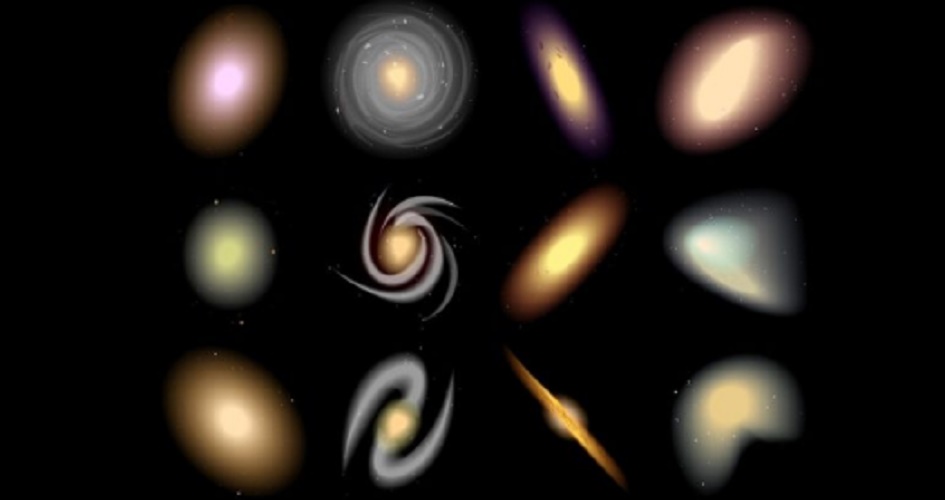What is a galaxy?
We explain what galaxies are, how they formed, what types and how many exist. Also, what are galaxy clusters.
-
What is a galaxy?
A galaxy is an astronomical structure that groups sets of stars (in their respective solar systems) and interstellar matter such as gases, asteroid fields, etc., in the same more or less defined astronomical system. That is, the galaxy is a set of stars and planetary systems that orbit a defined center or axis.
Our planetary system is part of a galaxy we call “Milky Way . ” It is located in one of its outer regions and far from the center.
Its name comes from the Ancient Greek Culture , since the observers of the night sky at that time assumed that this huge white spot that runs through the sky was remains of the mother’s milk spilled by the goddess Hera when she nursed the mythical Heracles (Hercules).
Galaxies are huge structures, as will be understood, that vary greatly in shape, size and composition , but are among the brightest objects observable with the help of specialized telescopes .
It is estimated that galaxies are composed of 90% dark matter , although the existence of the latter was not proven. Although they have different forms of organization, the vast majority of galaxies are flat disks of matter moving in space.
Galileo Galilei discovered in 1610 that the Milky Way is made of thousands of small stars . That was a very important step in the human understanding of celestial structures, especially those larger than our Solar System .
However, the formal understanding of the existence of a galaxy was not recognized until the end of the 18th century. Only at the end of the 19th century William Parsons built a telescope that allowed the first observation of galaxies . Until then they were simply called “nebulae.”
-
How do galaxies form?
The galaxies were formed in the same way as the rest of the stars and astronomical objects, and traces of galaxies have been found so old that they would have emerged just 750 million years from the Big Bang (we talk about the IOK-1 galaxy).
The exact mechanism of formation of these galactic systems is unclear, but there are two possible approaches from multiple theories proposed:
- Those that go from the bottom to the top, that is to say, that suppose that first clusters and small agglomerations of stars arose that little by little were organized as a system
- Those from top to bottom, which on the contrary assume that initially protogalaxies were formed , as a result of a large-scale collapse over a hundred billion years.
The key and today recognizable structures of galaxies appeared after billions of years of evolution and formation. They were affected by mutual attractions and eventual collisions, the result of which many galaxies merged or were absorbed by larger ones.
-
Types of galaxies

There are, according to the model proposed by Edward Hubble (the “Hubble sequence” of 1936) and still in force, four types of galaxies according to their apparent form:
Spiral galaxies . These are rotating discs of stars and interstellar gases that orbit a bright nucleus of older stars, forming “arms” around them in the form of a spiral, of less intense brightness. These galaxies in turn can be classified into:
- Spiral galaxies with stellar arms . Those that have “arms” with greater or lesser proximity of the nucleus.
- Barred spiral galaxies . Those that present a central bar or band of stars in the nucleus.
- Intermediate spiral galaxies . Those that are between the barred galaxies and those lacking “bar” in the center.
Ellipticals . Those that have an ellipse shape, and that are usually named from E0 to E7, indicating with the number how oval their shape is (E0 a sphere and E7 a disk). They tend to show little structure to the observer, and are dominated by old stars, which orbit around the center in random directions.
Lenticular galaxies . It is a transition group between spiral and elliptical galaxies, although they also have a disk and an extensive envelope. They can be barred or not.
Irregular galaxies . Finally there are galaxies whose shape does not fit into any of the previous categories. They may have a certain degree of structure or be more dispersed, and this may be due to the fact that they are still in formation, or that they are the product of some long-standing collision between galaxies.
-
How many galaxies exist?
It is estimated, according to observations from the 2016 Hubble telescope, that there are at least 2 billion (2,000,000,000) galaxies in the observable universe , almost ten times more than previously thought.
-
Clusters of galaxies
Galaxies are not simply scattered in the universe, but are usually part of larger structures known as clusters , which in turn can join and form superclusters.
Clusters of galaxies consist of a hierarchy of aggregates. Between them there are gigantic extensions of dead (or empty) space in the universe.
-
Examples of galaxies

Some of the best known galaxies are:
- The Milky Way . Our spiral galaxy has a diameter of about 100,000 light years and contains about 200,000 to 400,000 million different stars, of which the Sun is just one of the smallest, located at a distance of 25,756 light years from the galactic center.
- The Andromeda Galaxy . Also known as M31 or NGC 224, this is our neighboring galaxy, with which the Milky Way will collide and merge within approximately five billion years. It is the furthest object visible to the naked eye from Earth, located 2.5 million light years above the Andromeda constellation and is a spiral galaxy, like ours.
- The Triangle Galaxy . Also known as M33 or NGC 598, it is located in the constellation of the triangle ( triangulum ) about 2.8 million light years from Earth. It is gravitationally attracted by the Andromeda Galaxy, with a separation of just 720,000 light years from it, although it is much smaller in size (“barely” between 30,000 and 40,000 million stars).





